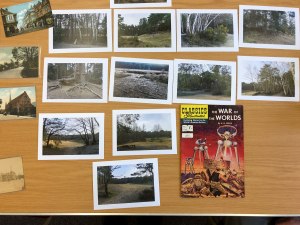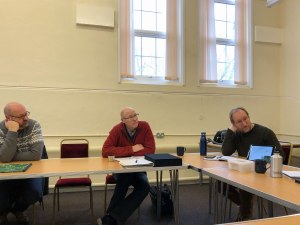This was an informal group session with eight of us present. We began with Jonathan bringing us up-to-date on place for the rest of this Academic Year’s sessions; had some discussion about latest notifications from OCA re tracking of students’ active learning and then moved onto discussion of works in progress.
Dawn:
Has been preparing a PechaKucha Presentation on her MA Body of Work ‘Digital Afterlife’. I was amazed how much information she was able to provide with such a short time slot available. (I found a good resource here for further general information). Dawn also had an image in a recent book, Women – Inspiring Quotes and artistic Responses Vol. 2. Dawn had responded to an open call she had seen on CuratorSpace asking for women artists to provide a quote from an artist or writer who inspires them, together with an artistic response to this. CuratorSpace looks very useful; it’s a project management toolkit for curators, organisers, galleries, and artists, which is designed to simplify managing exhibitions, competitions etc, by allowing organisations to create open calls inviting people to submit ideas, projects, and art work quickly and easily. I’ve now subscribed to their newsletter and they are also on Instagram, Facebook and Twitter.
Me:
I had taken along 7×5” prints of my current choices for Assignment 5 which has H.G. Wells’s ‘War of the Worlds’ as inspiration and Horsell Common as a subject. I asked for feedback on the sequence and suggestions about suitable texts (as there is no text at the moment)also showed the postcards I had selected. I also showed the vintage postcards I had bought from eBay as I was thinking about ways in which I might be able to incorporate them, and explained I would like to create a handmade book and have also thought of an ‘altered’ book as I have several copies of ‘War of the Worlds’.
Everyone was very interested in and positive about the sequence and the concept – one comment being “There’s plenty of meat in this”. However questions were asked which indicated to me that I needed to be clearer about my choices/sequence and what I was portraying. Was I looking at Horsell Common from a Martian’s point of view, is it about the Martian War itself, before it happens or when it’s ended? Suggestions were made that I could follow the sequence of the story/part of the story which covers Horsell Common; or insert a link to a Martian tripod by photographing trees from underneath. Another suggestion was that, if it’s connected with the Martian having landed then it would be appropriate to end the sequence with the creeping tree roots.
So far as adding text is concerned there was a consensus that I should include quotations from the book. Regarding the ‘altered’ book, one idea I’d had was to paint a watercolour overlay over my images (cf. the work of Aletheia Casey ) or even parts of the book. Another suggestion was to convert my photographs to black and white and then paint over them which is something Gerry has done in the past using acrylic ink rather than watercolour because it’s brighter and easier to use. Gerry also referred to a book he had seen where the pages got gradually redder. So far as the postcards are concerned, I could perhaps paint over copies of the postcard and then insert them in the book.
Richard
He is continuing to enjoy the book design course and showed us a zine he created for Assignment 1. ‘My Life in Books’. It looked very professional and he is also planning to create a photo-zine.
Jonathan
Used his iPad to show us some of his work for Assignment 3 ‘A Journey’. This is on his website and he has created a map of the journey a with accompanying slideshow. It’s a very effective and creative way of presenting a walk . We discussed whether ambient sound relative to the place would support the concept of change over time e.g. even the sound of breathing, also a suggestion that instead of right to left perhaps it would better show the direction of the journey relative to the map if left to right. Jonathan is also planning to create a giant cyanotype of the stones he collected on his walk. His Assignment 5 will be a project on land art, including a clever, and artistic, possible way of influencing walkers on a public right of way to stay on that as they walk through a private field.
Kevin
Work for Identity & Place. A series which utilises a processing technique he developed before studying with OCA and incorporates landscape scenes with objects which are important to him. Very distinctive prints with a slight HDR effect and printed on Permajet Pearl paper.
Michael
Talked us through the process and shared work produced in collaboration with an artist – part of a collaborative group submitting work for the forthcoming Edgezine online magazine. Each responded to work created by the other, from which new work was created.
Gerry
Shared work he had done for an Assignment for the Illustration Module. He experimented with using the cheapest possible ink and a foam brush. Really effective and a pleasure to look at.
During our lunch break Jonathan told us about a YouTube film which shows a 3D printer in the desert using solar energy and making glass Dawn showed us some work by Songwen Chung https://www.linkedin.com/in/sougwenchung who has created a robot that will draw with her ,and also some wonderful work by Helen Douglas on Weproductions http://weproductions.com http://weproductions.com/handprinted.html . There’s some ‘Poempondscroll’ (2010) a 5.7 metre x 21 cm scroll, printed on Chinese paper with ultra chrome inks. (out of print unfortunately)
The reflective expanse and circle of the pond at Deuchar Mill inspired Douglas to explore the scroll format, and gave Valerie Gillies the idea of writing a poem in Chinese form using couplets to encircle the creatures which live in the pond. The result, poempondscroll, is a horizontal hand scroll over 5 metres long, which visually evokes light and reflections on water, with an integrated text that merges and disappears within the rendered details of water insects, rushes and the pond itself.
Evolving out of the first scroll was ‘The Pond at Deuchar’ 14 metres x 27cm, continuing Douglas’s exploration of Deuchar Pond in deeper and richer colour and at greater length. This is also out of print but there was also a digital version of this and, if you have an iPad it can be accessed from here http://weproductions.com/epub.html .
It got me thinking that perhaps I could create a scroll book for Assignment 3 ‘Silent Pool’ must discuss with my tutor.
Thoughts
A very useful and supportive meeting demonstrating, once again, the value of sharing work with fellow students and asking for feedback. For me it’s actually more useful than online sessions because I can see the physical prints and books etc.
Actions for me are:-
- Reflect on my overall concept for Assignment 5 to make sure is it links coherently with the images
- Find suitable text from the book “War of the Worlds” to add to the book
- Do some experiments with watercolour paint or acrylic ink as a layer over some of my Assignment 5 images
- Discuss the idea of a scroll book for Assignment 3 with my tutor
- Richard created some beautiful handmade books when he studied Landscape so I will get in touch to ask for more details on his process.








Sounds brilliantly helpful. I live your ideas for the book using an old copy. (I’d stick with colour personally). There’s a an academia article in my inbox today about the alien in Ursula le Guin’s work, might be useful comparative reading for you
LikeLike
Yes – it really was. I’m currently composing a chart in preparation for my pre-assessment tutorial and have been thinking that I need a priority list of tasks so that I don’t rush off into experiments before I’ve done the foundation work. My impatience keeps tugging at me though.
I’m going to re-read Ursula le Guin’s “The Dispossessed” and Marge Piercy’s “Woman on the Edge of Time” – for pleasure but who knows what might crop up in the future.
LikeLike
What a great group! For scroll form books, UWE / Bristol’s printmaking summer school is running a course on them this year.
LikeLiked by 1 person
It is a great group.
Thanks for letting me know about the course Jennifer. Too late for Assessment purposes but I’ll have a look. Do you know of any online instructions too?
LikeLiked by 1 person
I considered making a scroll for one Drawing 2 project and knew the basics of construction because I’d lived in China and watched that type being made in a local art shop. But I also knew form that was beyond me! I’ve seen online instructions for that traditional Chinese type of scroll which some people who make traditional Chinese paintings do make. I’d seen a simpler form used for a piece of work made by an artist local to me and went round to her studio to ask how she’d done it so know there are simpler alternatives, but would still appreciate some tuition before making one.
LikeLiked by 1 person
Pingback: Further Reflection on my Concept for Assignment 5 | Portraying Landscape
It sounds like a really useful meeting Catherine. I’ve had a look at the ‘Curator Space’ website and that looks to be a worthwhile resource too. I am interested in how you progress with combining the old postcards with your own photographs and also adding quotes as this is exactly what I did in my reworking of assignment 3. Being unhappy with my Photoshop skills I ended up printing some onto vellum, looking through onto another image. I think that worked really well – we’ll see what the assessors say though!
LikeLike
CuratorSpace is certainly a good resource Anne – lots of information there.I remember your work for Assignment 3, particularly the book.
LikeLike
What a wonderful group Catherine, the eclectic range of work must be so inspiring to see. It’s so much better to see a physical piece of art than look online I think.
LikeLike
Pingback: Response to Tutor Feedback on assignment 5 | Portraying Landscape